Case Study Archive
Case Study - Lyme Bay
Background
Lyme Bay, off the Devon and Dorset coast, is one of Britain's finest sites for marine wildlife. It consists of rocky reefs that are a haven for corals, sponges and starfish. The reefs also support commercial species including crab, lobster and scallop.
Some forms of fishing, such as potting and scallop-diving, cause little, if any, damage to the reefs and can be considered sustainable activities in environmental terms. However, the Devon Wildlife Trust (DWT) has shown that dredging (rather than diving) for scallops is extremely destructive. Pink sea fans can take decades to develop, but dredging can destroy them in seconds. In the longer term it can also destroy the habitats on which pink sea fans and the rich associated seabed communities rely, so that recovery eventually becomes impossible.
DWT has been studying the reefs for 15 years and has campaigned for their protection. During the 1990s, DWT worked with the local fisherman and in 2001 negotiated a voluntary agreement to stop scallop dredging in two parts of the Bay. This agreement broke down in 2006 demonstrating the need for a statutory approach. Natural England subsequently called upon Defra, with the backing of The Wildlife Trusts, to introduce an Order to stop the damaging activity.
At the beginning of September 2007 Defra published a consultation that proposed three options for protecting Lyme Bay's marine wildlife. DWT, working in partnership with Dorset Wildlife Trust and national staff from the Royal Society of Wildlife Trust (RSWT), immediately began a 12-week campaign, the length of the Defra consultation, in support of the only option that offered full protection to the reef habitats, full closure of the Lyme Bay Reefs to scallop dredging.
Strategy
Identification of the campaign target was simple. The Fisheries Minister, Jonathan Shaw, would be making the final decision on the future of Lyme Bay Reefs. On taking advice from national colleagues, the Fisheries Minister was confirmed as the key figure to target.
Publics
Five key audiences with potential to influence Jonathan Shaw were identified:
- Hilary Benn - as Secretary of State for the Environment, and therefore Jonathan Shaw's direct superior, it was considered important that Hilary Benn was made aware of the campaign, and the extent of public feeling behind calls to protect the whole of Lyme Bay Reefs.
- Parliament - it was clear that Parliament, both the House of Lords and House of Commons, would have significant potential to influence the Minister, raising and keeping high the profile of the consultation and, highlighting the importance of the decision to be made.
- Consultation responses - central to the campaign had to be getting a large number of responses to the public consultation. But more than simply numbers, the Minister needed to see that our view had wide support, form a range of individuals and organisations, including those who might not normally be expected to respond to a consultation such as this.
- Public - ultimately the Minister, and all politicians, are responsible to the public. Although their influence may be small compared to more immediate stakeholders it will provide a background to the decision that may play an important part in the decision making process.
- Media - although more of a means of getting messages out than an audience in its own right, getting the consultation and campaign into the media spotlight was considered a vital means of supporting campaign work with all other audiences.
It was immediately clear that while the overall message in support of protection for the whole of Lyme Bay Reefs was common to all audiences, a range of materials and approaches would be required.
Tactics
The following were produced to support lobbying and campaigning activities.
- Website - www.savelymebayreefs.org was set up to act as a repository for all campaign material and as a major means of communication with the public. Almost all of the other materials were made available through this site, setting out the history of DWTs involvement with Lyme Bay Reefs, summarising the arguments for their full protection and showing people how they could support the campaign.
- Lyme Bay Reefs report - summarising the 16 years of DWT's work studying Lyme Bay Reefs and working to protect them from damaging impacts of scallop dredging. This was made available to the public through the website, but also used proactively to raise awareness with key organisations, individuals and MPs.
- Campaign postcards - these were produced to allow members of the public to contact Hilary Benn in support of the campaign. The postcards had two tear-off parts, one to post to Hilary Benn, and one to post to DWT to allow numbers of responses to be monitored. All members of Devon and Dorset Wildlife Trusts - around 25,000 households - were sent postcards in a direct mailshot. Around 2000 postcards were distributed to Wildlife Trusts in other parts of the country.
- E-petition - a previous RSWT campaign had collected e-petition 'signatures' to demonstrate public support for an effective Marine Bill. This was provided by an external web design team and based around an animated character 'Bernard the Gurnard'. This was readily adapted for use in the Lyme Bay Reefs Campaign. An email address was negotiated with Defra for them to receive electronic consultation responses in favour of full closure. Whenever one of these was sent to Defra, an email was sent to DWT to allow responses to be monitored.
- Scallop dredge - it is difficult to bring home just how damaging scallop dredges can be to seabed habitats. While 'before and after' images can be useful it was considered that an actual scallop dredge would be useful in showing just what the seabed habitats of Lyme Bay Reefs had to put up with. A scallop dredge was borrowed from Sussex Sea Fisheries Committee to use in photo-calls and to demonstrate to DWT members
- DWT Consultation response - a detailed consultation response was drawn up and submitted to Defra. This response included a series of comments on the form of the consultation itself as well as answering the specific questions asked. A copy of the response was posted on the DWT website.
- Sample responses - a number of shorter template responses and letters were drawn up and posted on the campaign website to support work to encourage other WTs and key volunteers to respond to the consultation.
Other activities
A wide range of activities were carried out, aimed at getting the basic campaign message across to all audiences. Direct approaches to the public tended to focus on key groups such as WT members or divers.
- WTs Annual Meeting - at the annual meeting of the Wildlife Trusts national partnership it was resolved to send a letter to Hilary Benn in support of the full protection of Lyme Bay Reefs. This was signed by Directors and Chairs of all Wildlife Trusts present at the meeting, 45 of the total network of 47.
- EDM 359 - Adrian Sanders, MP for Torbay, put down an Early Day Motion (EDM 359) welcoming the Defra consultation on the future of Lyme Bay Reefs and supporting their full protection. Early Day Motions do not have any legislative outcome, but they do allow political support for specific issues to be expressed through the gathering of MPs' signatures. By the close of the consultation 56 MPs from all major parties had signed EDM 359 , a good total for what was effectively a local issue.
- Letter to all English MPs - in partnership with RSWT a letter and copy of the Lyme Bay Reefs report was sent to all English MPs, highlighting the issue and urging them to sign EDM 359. On advice from national colleagues, Welsh and Scottish MPs were excluded from this initiative as a result of current issues over devolution and marine legislation.
- Adjournment Debate on Lyme Bay Reefs - Oliver Letwin, MP for West Dorset, entered the ballot for a close of business adjournment debate in the House of Commons. These are short debates with only two major speakers, the MP raising the debate and the appropriate responding Minister. As they are held at the end of business, the House is usually empty apart from the two speakers and House of Commons officials. Again, these debates have little legislative outcome but are a good way of raising issues directly with a Minister. The debate, including the response, becomes a matter of public record. Because of this, the Minister's response was non-committal, though some hints as to the way that he was thinking were detected.
- Written questions in the House of Lords - previous contact with an Environment spokesperson in the House of Lords provided the opportunity to get a number of written questions put down in the order book. These are for information only and cannot be used to make political points. However they do serve to keep the issue 'live'.
- Lobbying other organisations - in order to maximise the number of consultation responses from like-minded bodies, key organisations and individuals were identified at a local, regional and national level. Environmental NGOs and partnerships were seen as a main focus, but other organisations that might be expected to have an interest in the issue were also included. The aim was to let the organisation know that the consultation was live and to make the case for full protection. Bodies contacted included local authorities, water companies, national sports diving organisations, IEEP, a European policy 'think tank' and Marks and Spencer. At the time of writing it is not known which of the organisations contacted made a response, and if so, which option they supported.
- Using the WTs partnership - the Wildlife Trust's national partnership was seen as a key source of responses to the consultation. It is rare that all county and national Wildlife Trusts are asked to support a local campaign, but following discussions with colleagues it was decide that the national implications of this decision for marine conservation were such that an appeal to all 47 WTs to respond would be made. This appeal, which took the form of a letter from the CEO of RSWT to all WTs directors, was supported by the provision of a draft template response for individual WTs to customise before sending.
- Media campaign - a media plan was drawn up, identifying key opportunities for media engagement during the 12-week consultation. Media peaks were based on a range of opportunities, including the launch of the Lyme Bay Reefs report, a survey of pink sea fans washed up on a local beach and the DWT AGM, where the scallop dredge made a useful focus for press activity. Press releases were sent to the press and media contacts. Significant coverage was achieved in local and regional TV, radio and press.
- Marketiers - a London-based PR company, Marketiers, had previously been used, with great success, by a national WTs marine campaign in support of the Marine Bill. It was decided to approach them with the Lyme Bay Reefs story in an attempt to gain national coverage. Briefings and background materials were provided to support the 'selling' of the story to national outlets. As a result the issue was featured on Radio 4's Today programme and BBC Breakfast News.
- Exhibition attendance - initial reports of damage to the Lyme Bay Reefs had come from sports divers back in 1992 and this group was seen as a potential source of support. National WT colleagues had already booked a stand at the Birmingham Dive Show and the Lyme Bay Reefs campaign became the focus of this event. A street theatre group had already been engaged and through their performance as mermaids attracted many visitors to the stand and were successful in raising the profile of the campaign.
Results
The ultimate success of the campaign can only be judged when Jonathan Shaw makes his decision on the future of Lyme Bay Reefs. In early 2008, Defra published a summary of the consultation responses, which can at least provide an initial indication of the campaign results.
Summary of consultation responses
The results described here are based on the summary of consultation responses published by Defra in March 2008.
- E-petitions - E-mail returns suggest that around 3,000 responses to the consultation were made through the e-petition.
- Standard letters and postcards - the Defra summary reports the number of standard letters and postcards received as a result of the DWT campaign. However, these figures are not included in the detailed analysis of results and the summary does not mention which option for the future protection of Lyme Bay Reefs they support.
The total number of standard letters received by Defra was 41, the total number of postcards 7,751. Based on an estimated 40 000 postcards distributed, the figure suggests a 19% support rate, high for this type of campaign.
- Unique responses - the Defra summary reports a total of 108 unique responses remaining once the standard letters and postcards are removed. The table below sets out Defra's results for the number and percentage of unique responses supporting each of the consultation options - where option C provides for full protection of the Lyme Bay Reefs. Further analysis by Defra shows that the 80 responses in favour of Option C include responses from all sectors: Academic, Commercial, Individual, NGO, Public Body and Recreational users.
|
Option |
Number of respondents supporting this option |
As a percentage of total number of unique responses |
|
A |
24 |
22% |
|
B |
2 |
2% |
|
C |
80 |
73% |
|
No option indicated |
2 |
3% |
|
Total |
108 |
100% |
The figures suggest a good result to the campaign in support of full protection for the Lyme Bay Reefs - option C. Tempting though it might be, it cannot be assumed that all the 80 responses supporting this option were a result of the DWT campaign. It will be possible to make a more detailed assessment of the success of the campaign, particularly in relation to the lobbying strategy, when copies of all the responses have been obtained from the Defra library and analysed.
Top tips for organising a campaign
Good project planning - crucial to keeping all activities on track
- Good communications - important to keep everyone updated with changing situations
- Resources - enough staff time and money to deliver
- Contacts - a good existing range of contacts to allow campaign to gain momentum rapidly
- Organisational profile - with the DWT Director a key member of the project team, the campaign maintained a high profile within the organisation
Written by Rod Birtles
Case Study - Salaam Shalom
Background
In April 2006 funding was received by the Bristol Muslim Cultural Society (BMCS) to establish an internet radio station focusing on Muslim/Jewish dialogue. Over the following 10 months the project was developed into a stand-alone organisation, Salaam Shalom Ltd, and on 1st February 2007 Radio Salaam Shalom 'went live'.
Based in Bristol, the station broadcasts a mixture of music and speech-based programming focusing on Muslim and Jewish issues and dialogue. In its broader role, it also provides a platform for members of both communities, and those of other faiths and cultures, to explore the similarities and differences between the two, the perspectives they bring to contemporary issues, and their impact on others.
Radio Salaam Shalom has now involved more than 50 volunteers, supported by a full-time Station Manager. It has also reached a wide audience in the UK and around the world. Issues discussed range from food to marriage, religious practices to rap lyrics. Presenters' ages range from 11 to beyond retirement.
Programming is all English language unless quoting from Hebrew or Qur'anic texts. Music is a mix of world music, with a focus on Middle Eastern and Jewish or Muslim inspired themes. Programme content has also been received from organisations worldwide, including Israel, Ramallah, the USA and South Africa.
The station runs a number of outreach programmes, offering training to local youth groups, schools and cultural organisations. These have resulted in some additional programming.
Objectives
The key public and media relations objectives were clear. In the first year, the public relations focus was on raising awareness within the local Muslim and Jewish communities to establish a volunteer base and to approach national, Muslim/Jewish organisations and interest groups to gain support for the project. Media relations also focused on awareness-raising to establish an audience.
Following launch the objectives were to retain and increase the volunteer base - extending beyond the local communities - and use milestones and successes to generate media coverage to maintain and increase listenership and visitors to the Radio Salaam Shalom website.
In some ways, the public and media relations task was relatively easy. The project was set up at a time when Islamophobia, anti-Semitism and Muslim/Jewish relations were high on the media agenda and in full public view. National and local government initiatives were being set up in an attempt challenge some of these issues and Salaam Shalom presented an ideal opportunity for positive news. The project was also, and remains, unique in the UK and one of about 10 such projects worldwide.
However the project faced, and still faces, significant PR challenges. From a public relations perspective, convincing members of both communities - locally and nationally - that the project is viable, achievable and positive has been a major task. The accusation of 'wearing rose tinted spectacles' and 'preaching to the converted' is ever present. In addition, particularly with older members of the communities, the need to overcome suspicion and long-held (often ill-informed) views of the two faiths and cultures remains a barrier to dialogue. Because of this, the public relations focus had to be inclusive, but with a focus on the younger members of the communities.
The media challenge was three-fold. Avoiding the obvious 'conflict' stories; ensuring that "Muslim and Jew" was not reduced to "Arab and Israeli"; and encouraging the broadcast media in particular to talk about the station. Because one key message was "Radio Salaam Shalom is the voice of the moderate majority", the media also had to be convinced that 'moderate' did not mean 'bland' or un-newsworthy.
Strategy
Public relations strategy focused on establishing a volunteer base. It was recognised that while Radio Salaam Shalom is Bristol-based, there were opportunities to recruit programme-makers from beyond the local communities as well as locally.
Strategically, it was felt that initial local face-to-face meetings would be the best approach using the limited resources available. As the station became established this could be extended to a national, and possibly international strategy. At the same time, local and national opinion-formers would be approached, initially through existing contacts.
The media strategy took a two-pronged approach. The first was short-term, news-based, which would offer regular opportunities for local and regional media to talk about the project. In addition, from the outset of the project, there was a longer-term, feature/documentary-based strategy which encouraged network media to follow the progress and development of Radio Salaam Shalom through launch and beyond.
Tactics
The public relations tactics involved members of the organizing committee and Station Manager visiting local community groups, cultural centres, etc to discuss the objectives of Salaam Shalom. In addition they contacted, and where possible, visited, Muslim/Jewish dialogue groups in other parts of the UK. As the volunteer base grew and a full-time station manager was appointed, this activity increased to include attendance and presentations at conferences and forums, training workshops and the development of outreach programmes.
In a number of cases, key opinion formers were identified from internal contacts and the partnership with BMCS. Others proactively contacted the station. Where possible, these opportunities were leveraged for fundraising and to contact further opinion formers.
As partnerships were established with local, national and international organisations, these were used to further develop awareness of Radio Salaam Shalom as well as allowing the station to provide a broadcast platform for other organisations and projects.
Initial media contact was with specialist publications (e.g. the Jewish Chronicle and Muslim News) to announce initial funding and the name of the project. This was followed by calls to key feature writers and documentary producers, including the BBC, to discuss opportunities.
As the date approached for the 'on-air' launch, local, regional and national media databases were established; tailored media releases created and distributed under embargo; key media contacts were called directly by 'phone; a 'bookings' diary set up for interview requests and spokespeople identified and briefed on key messages.
While maximising the opportunity of the 'on-air' launch date to generate a focal point for initial media activity, it was important that this momentum was continued beyond the first day of broadcast. Online blogs, e-newsletters and news forums were monitored and fed with information. Post-launch a number of news stories were identified during the year to maintain media awareness.
A further, major media push was generated for the first anniversary celebrations of Radio Salaam Shalom, contacting media that had been involved in launch coverage
plus additional contacts that had been established in the first year of broadcasting.
Results
After just over one year of broadcasting, Radio Salaam Shalom has included more than 50 volunteers in regular programming and other production activities. In addition it has created awareness of the organisation amongst the local communities both as a stand-alone project and as a partner for a number of local broadcasting and youth development initiatives including Radios Hajj and Ramadan and BCfm (Bristol's main community FM radio station).
Within two months of launch, Radio Salaam Shalom had linked with a number of major dialogue-based organisations in the UK and Europe and was part of the UK delegation to the first European conference on Muslim Jewish Dialogue.
Through concerted public relations activity, Radio Salaam Shalom was also asked to attend and broadcast from Limud - one of Europe's largest Jewish cultural festival - plus a number of other forums, workshops, conferences and debates. In addition the station received approaches from other UK cities including Glasgow and Manchester to investigate outreach, training or partnership opportunities.
Media coverage significantly exceeded the expectations of even the most optimistic members of Radio Salaam Shalom. The following is a summary, not exhaustive, of the coverage achieved during and since the 'on-air' launch:
NEWS:
Print:
- A number of photo stories in Bristol Evening Post, Western Daily Press, plus nibs in a number of national newspapers, Jewish Chronicle, Muslim News, Jewish telegraph, Asian Times.
Broadcast:
- Approximately 30 interviews on BBC local and network radio and TV. A further 10 on independent radio, plus news clips and interviews on international media including CBC (Canada), RAMfm (Israel/Gaza), Triple J (Australia), Press TV (Iran)
Online:
- Hundreds of syndicated news stories on websites in many languages worldwide.
FEATURES:
Print:
- Jewish Chronicle
- Cover story - Inside Track (Home Office)
- AirFlash (the national magazine of the Community Media Association)
- Islamic Times
Broadcast:
- BBC RADIO 4 (30 min documentary)
- BBC World Service Arabic
- BBC Inside Out West (15 minute feature on launch, 5 minute feature on 1st anniversary plus live coverage)
- More4 (5 min feature on launch)
- BBC1 Heaven And Earth (10 minute feature)
- RAI2 (Italian National TV)
- NHK Japanese international TV
- BBC WORLD (3 minute feature)
- AL JAZEERA (5 minute feature)
- PRESS TV (Iran international satellite channel)
- Muslimcafe TV (20 minute panel discussion, online TV).
Evaluation
Evaluation for this project has been conducted internally, without the use of media cuttings or evaluation services.
Overall the results of both media and public relations activity have been extremely positive, although recent evaluation has highlighted the need for increased activity in audience retention and enhanced online communication.
Public relations activity has delivered five major partnerships and a number of lesser relationships which have directly provided additional programme content or will directly impact on future fundraising opportunities.
The volunteer base has grown steadily from three months prior to 'on-air' launch. Volunteers were initially split approximately 50/50 between the Muslim and Jewish communities, despite the fact that the Jewish community is Bristol is extremely small (an estimated 500 people) with a significantly greater Muslim community (approximately 30,000). Over recent months, an increasing number of volunteers from other faiths and cultures have become involved in Radio Salaam Shalom, however the programme content has remained focused on Muslim and Jewish themes.
Attendees at the 1st Anniversary celebrations, plus conversations with local and national government and media representatives indicate a high awareness of Radio Salaam Shalom amongst target audiences for fundraising and partnerships.
Funding applications are currently pending, so it is too early to establish whether the public relations activity has had a direct impact in this area.
Media evaluation is based on MediaTrack methodology, focusing on favourability and delivery of key messages. It is estimated that overall favourability of media coverage to date would be +2.8/+3, assisted by network broadcast features and documentaries. There has been no negative media coverage and, in general, at least one key message has been delivered in every piece of coverage.
Online media has added to the favourability rating as, in an estimated 70% of coverage, copy used has been taken directly from Radio Salaam Shalom's own media releases, ensuring high delivery of key message. Where comment has been added - either by editors or by site visitors - this has been positive overall.
Although positive, evaluation has highlighted a need for greater proactivity with target media - in particular ensuring that smaller milestones or news items are offered to them more frequently. Where Radio Salaam Shalom has been featured on broadcast media there has been a noticeable uplift in visitors and listeners to the Radio Salaam Shalom website, but evaluation has also shown a need to focus on audience retention.
The experience gained in the first year of broadcasting, and information gathered from evaluation and anecdotal evidence, will be put to good use as Radio Salaam Shalom grows in stature and presence across the UK and through its global audience.
Written by Peter Brill
Case Study - Closer To Smiles
Analysis
T-Mobile is a socially responsible company, especially dedicated to the health sector and is active in all regions and towards all social groups.
Traditionally, during the month of December, T-Mobile organizes a humanitarian drive Closer to Smiles and gives presents to children who spend holidays in hospitals throughout Croatia. The presents are collected by T-Mobile employees themselves who thus show their humanity. T-Mobile as a company doubles each present.
As opposed to previous years, in 2007 the presents were collected by employees from all the companies that make the T-HT group. A lot more presents were collected and it was decided to bring Christmas cheer to more children who would not spend holidays with their families.
In 2007 some new elements were introduced - magic shows by a famous illusionist, visits of celebrities and a possibility for employees to give presents together with the Santa Claus and the Good Fairy.
During 15 days the Santa Claus and the Good Fairy, accompanied by the illusionist Luka Vidovic, gave more than 4 thousand presents to children in all hospitals and 20-odd children homes throughout the country.
Strategy
Strengthen the perception of a socially responsible company dedicated to the health sector that conducts its activities in all regions and toward all social groups alike.
Goals
- Bring the Christmas cheer closer to all children in hospitals and homes
- Improve the positive perception of T-Mobile and T-HT as socially responsible companies that support various projects in the community
- Ensure recognition of T-Mobile as the company that every December conducts the drive "Closer to Smiles" and tries to provide children in hospitals with Christmas magic
- Create additional recognizability of T-Mobile as the company that is especially linked to the health sector in its socially responsible operations
- Continuing linking to the claim "Simply Closer" - with this drive T-Mobile shows that it is closer and understands the needs of its customers and wider community
- Improve the unity of T-Mobile and T-HT employees
- Improve internal communication in the company
Publics
- Internal public: employees of T-Mobile, T-HT and T-Mobile International
- General public
- Hospital personnel and parents (children)
- Home personnel and parents/guardians (children)
- National and local media
Key Messages
- T-Mobile takes care of needs of children and brings the Christmas cheer closer to children in hospitals and homes
- T-Mobile wishes to make the drive "Closer to Smiles" a traditional one that is recognizable for the month of December and introduced novelties every year
- Besides presents T-Mobile also gives the entertainment program
- T-Mobile understands the needs of the community in general and wishes to help those that need it the most
Execution (instruments and time plan)
Instruments:
External communication
The drive was communicated solely via PR tools. The interesting content resulted in press coverage without additional costs (as this was a humanitarian drive and an advert could have negative implications). External communication was done through print and electronic media, Internet, external publications of T-Mobile and on T-Mobile web pages.
Participation of celebrities (national and regional) resulted in an increased interest of media during the month rich in humanitarian drives.
Press clippings successively followed each visit to hospitals and homes.
Internal communication was done continuously towards employees in all phases of the project via Intranet, internal news and e-mail delivery of press clippings as well as the personal participation of employees who visited hospitals and homes
Term plan:
November 9, 2007 - internal communication started with the first internal news, distribution of tulle gift bags to all employees and posters at all locations.
December 5, 2007 - start of the hospital and home tour is the start of the external communication
December 21, 2007 - end of the drive
EMPLOYEES were part of the drive from the very beginning. In the first phase of the project, from November 9 until December 4 they personally collected and wrapped presents and from December 5 until December 21 they went to hospitals and homes to visit children in hospitals and homes throughout Croatia and personally bring presents together with Santa Claus and celebrities. Their reaction was extraordinary and they felt their active role in bringing holiday cheer to sick children and children without parents.
Impact and Manner of Evaluation of Success of Communication:
The project resulted in media coverage during December.
The planned number of clippings was exceeded; there were 70 press clippings in total. On average daily there were 3 press clippings in media about on the course and the realization of the drive.
The press clippings were distributed in the following manner:
- 36 in print
- 14 on the net
- 3 on TV
- 17 on radio
The titles: PR as initiator and executor of social responsibility, T-HT employees give presents to children without parents, Humanitarian drive Closer to smiles, Special show, Closer to smiles in Klasje, Osijek soccer player in T-Mobile's drive Closer to
Smiles, Presents for children from Klasje, County puls, Zuhra brought joy to children in hospital, Zuhra and Santa Claus gave presents, Putting smiles with presents, Presents for children in hospital and home, Stars for a child's smile, Giving presents as an expression of humanity, Drive Closer to smiles put smiles on faces of children
In Pula hospital and home, Interview on air, Santa Claus and Good Fairy put smiles on children faces, They were visited by Santa Claus and fairies, Be my friend, Frontman of Pips, Santa Claus' right hand, Celebrities brought joy to children, Closer to smiles with T-Mobile and T-HT, Christmas solidarity, They gave presents to children in hospital and home Svitanje, Toys and books for small patients, Happiness from the bag, Donations of T-Mobile
Market research has shown the positive opinion of the public about this humanitarian drive which contributed to the positive perception of the brand. Role of T-Mobile as a socially responsible company and initiator of humanitarian drives has additionally been affirmed.
BUDGET - 46.000
Creativity and Innovation
T-Mobile creatively used communication tools and successfully integrated brand values in the humanitarian activities of a socially responsible company.
Written by Lada Askic
Case Study - Napoli
MSC Napoli incident - the view from East Devon District Council
Background
If one incident could define the need for many agencies to work together seamlessly and flexibly, it would be the ship that suddenly arrived off the East Devon coastline in January 2007.

The container vessel MSC Napoli was beached off the East Devon section of the World Heritage coast, between Sidmouth and Branscombe, on Saturday 20 January 2007. The vessel had suffered flooding to the engine room during force 8 gales on Thursday 18 January 40 miles south of Cornwall. This occurred in International waters within the French Search and Rescue zone. The 26 crew abandoned ship and were safely rescued from their lifeboat by helicopter. Following discussions between the UK and French authorities and assessments about suitable places of refuge, a decision was taken to tow the vessel to a place of refuge in UK waters. The MSC Napoli was carrying some 2,400 containers and 3,600 tonnes of heavy fuel oil. The worsening condition of the vessel was such that while under tow in bad weather to Portland for repairs, a decision to beach and ballast the MSC Napoli about 1 mile east of Sidmouth was taken by the Maritime and Coastguard Agency (MCA) to minimise the impact of any pollution from the vessel's cargo.
Over 100 containers were lost overboard that night, more were lost in subsequent poor weather, a large number of these came ashore at Branscombe and nearby beaches. Oil escaping from the vessel was minimised, but some found its way ashore, mostly drifting eastwards towards Dorset (a number of containers had also floated that far).
EDDC staff were immediately put on alert and a pre-arranged Emergency Plan swung into action. EDDC's website announced the news and our offices were turned over for use as a control centre and Press facility for international media representatives, who flocked to Sidmouth in droves.
Containers that had washed off the deck floated ashore at Branscombe and attracted hordes of treasure-seekers, who invaded the village and laid waste to the beach. The mess involved StreetScene in a massive clear-up operation.
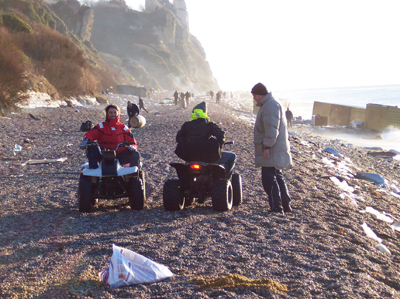
Meanwhile, members of the public were generous in their offers of help to clean the beaches and they were mobilised just before the Easter holidays. Beaches along the East Devon coast were returned to pristine condition, thanks to groups of residents whose efforts were co-ordinated by EDDC staff.
The owners of the MSC Napoli and their insurers appointed a Project Manager, who appointed contractors DRS Salvage to clean up the beaches affected. A Command and Control structure was established to cater specifically for this event. An on-shore Strategic Co-ordinating Centre (GOLD) was opened at the Headquarters of the Devon & Cornwall Constabulary at Middlemoor, Exeter, with two Tactical (SILVER) controls opened, one at Sidmouth hosted by East Devon District Council, and the other at Dorchester hosted by Dorset County Council.
These linked to the Salvage Control Unit (SCU) and Marine Response Centre (MRC) at the Maritime Rescue Co-ordination Centre at Portland, who led on the offshore response.
Assisted by benign weather conditions throughout February, work to remove the remaining containers and fuel oil from the MSC Napoli went well and on 26 February the last container was lifted from the deck of the vessel. Most of the fuel oil and diesel had also been removed by that date. Work proceeded through the Spring, with the last container being removed from the holds of the vessel on 17 May 2007.
In July the operation to re-float the ship, which led to the separation of the vessel into two parts, stimulated renewed media interest. In early August the bow and mid section of the vessel was towed to Belfast to be dismantled. The stern of the vessel is scheduled for removal during 2008.
The beach, coastal footpaths and roads in Branscombe were fully re-opened shortly before Easter 2007. The 675 tonne accommodation block was removed in November and it was hoped that phase one would be complete by the end of January, 2008, with the second phase, which is reliant on good weather conditions, commencing at the end of March. However, severe winter gales halted phase one operations and these have been postponed pending the arrival of better weather in the spring. This latest chapter in the Napoli incident underlines that throughout the degree of risk has been contingent upon the weather conditions.
The nature of the incident - a maritime problem with implications for the shoreline and many landward activities - meant that a large number of agencies were involved. Many of these had trained together for generic emergencies, but real-life dramas seldom conform to predicted scenarios.
Among the many agencies involved were:
- The Secretary of State for Transport
- The Maritime and Coastguard Agency (MCA)
- The MP for East Devon
- East Devon District Council
- Devon County Council
- Branscombe Parish Council
- The Police
- The Fire and Rescue Service
- The Environment Agency
- The National Trust
- South West Tourism
- Fishermen's Association
Objectives
The many agencies involved had a significant number of shared objectives and a small quantity of individual aims specific to the specialisms of each agency. The over-arching objective was to minimise the impact of the ship on any vulnerable place, person or business. Success depended to a large extent on the skill and professionalism of those tasked with the logistics of unloading and removing the ship; in the meantime, it was the task of those dealing with the media and the public to ensure that everyone understood how the operation was being handled and had confidence that everything was being done for the right reasons, in the right manner and so was under control. In a word: Reassurance.
There were a number of different audiences for this message of reassurance - and each with its own special needs and challenges. These included a broad spectrum of the public in addition to a number of key stakeholders:
- The Government
- The landward community
- The fishing community
- The tourism businesses
- The potential visitors
- The actual visitors
- Politicians - local and constituency
- Environmentalists
Strategy
The strategy devised to deal with the various challenges was based on a pre-planned and tested methodology which from the start had to be adapted at short notice in the light of circumstances that were changing rapidly and could not always be foreseen. The most significant influence on our strategy - and the least predictable - was the weather. The key component of EDDC's communications strategy was flexibility.
The basic strategy was based on known good practice and involved the following activities:
- Clear lines of authority (based on Gold, Silver and Bronze Command structure)
- Frequent meetings of all relevant partners
- Ensuring communication professionals were part of the team
- Sharing information among partners and stakeholders
- Making a careful choice of communications channels
- Forming a detailed and organic Communications Plan
- Informing the audience(s)
- Anticipating Media interest
- Proactively heading off Media interest
- Reacting promptly and informatively to Media enquiries
- Engaging with stakeholders
- Sharing experiences with partners
- Learning from mistakes and Implementing learning
- Planning next steps in advance
- Being flexible enough to adapt as required
Tactics
From the start, the tactics were to work as closely as possible with the media to ensure that the correct messages went to readers, listeners and viewers and that any mischievous media coverage was minimised and quickly rebuffed. This worked well most of the time.
Whilst all the communications professionals involved were equal partners, the MCA were the lead agency since they were in overall control of the seaward operation and also had the resources and infrastructure to deal with local, national and international media interest.
When the ship beached it was front page coverage on nearly all the nationals - the main issue they focused on was the people who were coming to take the contents off the containers. Coverage was mainly negative, with huge photos showing a beach strewn with litter and negative articles implying that local people were doing the scavenging. This encouraged more treasure seekers to invade Branscombe. They also questioned why the ship had been brought into Lyme Bay and speculated about the potential dangers (none of which materialised).
After the first few weeks the issue died down in the nationals. There continued to be lots of coverage in the local Devon/Dorset papers which tracked progress of the clean up operation and focused on what the various agencies were doing. The dismantling of the ship produced some very dramatic photos.
Positive coverage was a result of the press offices working on various angles. The broadcast of TV pictures from Branscombe beach which showed looters breaking into a packing case washed off the Napoli was picked up in South Africa by a Swedish woman who owned the goods being looted.
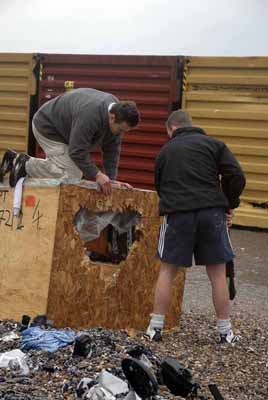
This presented EDDC with a PR opportunity later in the year. The woman - Mrs Anita Bokdal - visited the UK to recover some of her salvaged belongings and was invited to visit Branscombe. She travelled there at East Devon District Council's expense and stayed overnight in the village's quaintest pub. The following day a media pool met her and spent several hours interviewing her and filming her on the beach and in the village.
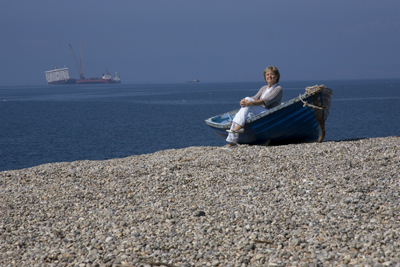
EDDC arranged for her to be presented with a number of souvenirs of her visit, including two bottles of a special beer brewed as a memento of the Napoli and a lucky horseshoe made by the village blacksmith. Widespread media coverage showed Mrs Bokdal beaming with pleasure at the hospitality shown to her and she was quoted as saying she intended to visit the village again as a tourist.
Meanwhile, EDDC's main concern was keeping the beaches clear of oil and cargo items so that holidaymakers could enjoy the beaches. StreetScene staff patrolled the beaches and liaised with salvage contractors DRS. Signs were put up at each resort giving daily updates on the condition of the beach. As summer turned to autumn and autumn turned to winter, the signs continued to be updated so that even in off-peak season any visitors would be aware of the condition of the beach.

The contractors clearing the beaches sent a representative to the regular operational meetings, where there was a regular communications slot on the agenda.
The communications plan agreed with partners such as the National Trust, Devon County Council and South West Tourism, resulted in a co-ordinated approach and a number of collaborative tourism-related publicity events. These included advertising and editorial features in the Times and Sunday Times.
Results
The Napoli incident could be viewed as an unwanted challenge but also as an opportunity to test in real-time how well the various agencies could cope with an emergency both operationally and in terms of communication.
Such was the success of the operation that it is viewed by the Government as a model operation that will be used to influence guidelines for handling future incidents of this type.
The main casualties of the operation were a relatively small number of seabirds damaged by oil. However, the rapid removal of cargo and fuel oil ensured that the environmental damage was kept to a minimum.
Evaluation
The outcome of the operation to save the cargo of the Napoli was as 'planned' - that is to say it was overall judged as successful, despite the early loss of some containers and the continued leakage of small quantities of oil throughout the operation.
Businesses in Branscombe were affected, as were the residents of the village with the initial influx of unwelcome visitors. Initial publicity may well have influenced people away from booking a holiday in the general area.
However, overall, many businesses in the general area have benefited from the presence of the Napoli - e.g. Sidmouth in January was described as 'busy as a Bank Holiday' with sightseers, and the coastal footpath between Beer and Branscombe experienced unprecedented use for the time of year.
EDDC staff were involved at many levels, including those looking after website content, the Emergency Planning Officer, the Press Office, StreetScene and Environmental Health.
Locally, EDDC worked with Devon County Council to provide community information and with the Salvage contractor to provide and update signs on every beach.
EDDC also worked with South West Tourism and with the National Trust to minimise the impact of the Napoli on tourism.
The role of Devon County Council
Devon County Council worked closely with all the agencies involved, including putting contingency plans in place to respond to developments should circumstances change at any point.
A management team was established to co-ordinate the County Council's activities including emergency planning, highways, public rights of way and traffic management, environment and conservation, communications and community liaison, tourism and the wider economy. The County Council has been represented at and played a key role in the strategic and operational inter-agency bodies set up to respond to the Napoli incident, at the Maritime Response Centre in Weymouth (MCA led), which led the at-sea response to the incident, and locally at Devon and Cornwall Constabulary headquarters in Exeter and at East Devon District Council's offices in Sidmouth.
Working closely with partners, the County Council has acted as a strategic communications hub collating and co-ordinating "warning and informing" communications to help ensure that all stakeholders are kept up to date with developments.
As the Highways Authority the County Council played the leading role in the traffic management response to the incident and working closely with Devon and Cornwall Constabulary took firm action to restrict access to Branscombe temporarily when the community experienced severe problems caused by the substantial influx of people intent on removing cargo from the beach.
The County Council has liaised closely with Branscombe Parish Council , provided £5,000 of financial assistance and instructed its highways contractors to make good roads that were damaged. The Executive Member of Environment has presented a record of newspaper coverage of the Napoli incident to the Branscombe community history project.
Devon County Council was the lead authority on the international EROCIPS (Emergency Response to Coastal Oil, Chemical and Inert Pollution from Shipping) project, which identified better ways to control and clean up pollution, especially in sensitive wildlife and fishing areas. The project successfully concluded in October 2007.
THE ROLE OF SOUTH WEST TOURISM (SWT)
The tourism industry in East Devon and West Dorset is worth around £400million in tourism spend, therefore it was vital that the correct information was communicated to the media, industry, and visitors at all times during the grounding of the MSC Napoli.
In the initial stages of the grounding, SWT was called upon by the media for interviews but was omitted from the 'official' communications and some of the initial messages took little account of the huge economic damage resulting from inappropriate comments from spokespeople. The result was a number of inaccurate and misleading messages, including references to 'beaches being polluted for the whole season', and tourism cancellations were seen as far away as the North Devon coast.
Over the first few days SWT senior staff made inroads into the Sidmouth command centre and ensured that MCA and others were briefed on the potential economic situation. Thereafter SWT became part of the official communications and co-ordinated a number of Communication Meetings with key stakeholders to share latest facts about the current situation and to agree clear responsibilities for communicating with the media / visitors and the tourism industry.
(Each message had to be tailored slightly differently to meet the needs of the specific audience).
TOURISM INDUSTRY
As SWT is the regional tourism body for the South West region it was vital that SWT kept the tourism industry up to date about the current situation, SWT's position and also informed about key information such as any legal implications
Therefore, a separate page was created on the corporate website with the following information, which was updated daily:
Example message:
MESSAGE TO THE INDUSTRY FROM SOUTH WEST TOURISM
Grounding of MSC Napoli
South West Tourism is currently monitoring the situation and ensuring that the correct information is being communicated to the industry and visitors. We are liaising with the Marine Coastguard Agency and Local Authorities, as it is an important time for visitor decision-making hence important that this is resolved fast so that everyone can book their holidays with confidence.
What should tourism businesses be doing at this stage?
We recommend that Devon and Dorset tourism businesses should be reassuring customers that the authorities are looking after the incident, and be optimistic that it will prove to be short-lived and be resolved quickly. Tourism businesses should also consider including something on their websites to reassure visitors of the incident and the main facts about the grounding, and possibly emailing, phoning or writing to customers.
What if visitors want to cancel?
This is up to the business terms and conditions, but we recommend that businesses offer exemplary customer service and take a long-term view of the value of customer loyalty. Should cancellations occur, businesses should also check with their insurance policies.
What could be the economic outcome on tourism for the East Devon and Dorset area?
It is too early to say. The impact to date has been localised and we're optimistic that it will be resolved without any major long-term damage. Once we have more information, we will update the industry.
VISITORS
In addition, it was vital that the visitors to the region were kept updated about the current situation, so a consumer message was needed. In this message it was also important to clarify to any visitors that this was a localised incident and did not effect the entire region.
The following message was updated daily on the consumer website.
Example message:
IMPORTANT VISITOR INFORMATION REGARDING THE GROUNDING OF MCS NAPOLI OFF BRANSCOMBE, EAST DEVON
South West Tourism is currently monitoring the grounding situation and ensuring that the correct information is being communicated to the industry and visitors.
The East Devon coast is an area of outstanding natural beauty and our primary concerns are that any damage to the local environmental is minimised and that visitors are kept fully informed and can enjoy looking forward to their visit with full confidence. We are working with the Marine Coastguard Agency and Local Authorities to ensure that these concerns are addressed as quickly as possible.
VISITOR QUESTIONS AND ANSWERS ABOUT THE GROUNDING OF THE MSC NAPOLI.
What should visitors do if they are worried about their holiday booking?
Visitors need to contact their accommodation provider or look on the accommodation provider's website for information. We would encourage visitors not to make any instant decisions at this early stage and to wait until it is clear what impact the grounding has had on the coastline.
During this time SWT were also involved in daily media interviews regarding the potential effect on the tourism industry and also with the PR / Marketing opportunities to promote the area, as discussed by EDDC and DCC.
Nick Stephen, East Devon District Council
With thanks to Helen Chater, Devon County Council and Liz Dale, SW Tourism
Case Study - GENERAL MOTORS - INTERNAL COMMUNICATIONS
Background
The General Motors UK & Ireland (GM UK & I) cluster is made up of the following brands; Vauxhall, Opel Ireland, Saab, Chevrolet, Cadillac, Corvette and HUMMER. With the growth of the GM cluster in the UK Saab joined in 2000 and Chevrolet (formally GM Daewoo) joined on 1st January 2005. The most recent additions to the cluster were Cadillac, Corvette and HUMMER in 2007.
With the development of this multi-brand strategy, all operating from the head office in Luton, an internal communication approach was needed which could help integrate the organisation and engage employees. With an already successful communication strategy at GM manufacturing plants the EXCITE employee engagement scheme focuses on GM UK & I head office.
Objectives
To accompany the growth of the GM UK & I cluster, building brand ambassadors and engaging employees.
Strategy
Based around 6 key behaviours this employee engagement programme focuses on building brand ambassadors. EXCITE is an acronym for the behaviours that support GM as a business: Enjoy, X-Factor, Customer Driven, In it to Win, Tell it how it is, Energetic. All communication is based around these 6 key behaviours with various tactics used to promote engagement.
Tactics
- EXCITE Inductions - All new employees are given an EXCITE orientation which includes background on the GM brands, introduction of the EXCITE behaviours and explanation of the EXCITE Award and Whatever Next? Initiatives.
- Posters - A visual display of the EXCITE behaviours throughout the head office. Branded, colourful and thought-provoking statements linked with the 6 key behaviours.
- PC Wallpaper - Similar to the posters. A visual reminder to all employees of the 6 key behaviours needed to support GM.
- EXCITE Award - Awarded to individuals or teams on a monthly basis who exemplify one of the EXCITE behaviours. Nominations are through colleagues and management who submit an entry via an intranet application.
- Hero Wall - Display area in the head office restaurant with photographs and information of teams meeting targets and EXCITE award winners. A method of congratulating and celebrating peoples' success.
- Whatever Next? - A feedback and suggestion scheme proposing ideas and issues relating to the working environment, facility enhancement, product marketing ideas and campaign intiatives. Responses are guaranteed within 7 days and all senior management review the submitted suggestions on a weekly basis. Since the launch at the end of 2004 1,348 ideas and issues have been forwarded with 64% actioned.
- Ride and Drive Events - These events accompany the launch of new GM products as well as give employees seasonal opportunities to drive various vehicles, such as soft-tops in the summer. One type of Ride and Drive event is run over a two-day period giving employees the opportunity to book a half an hour trial.
Another effective method is a monthly scheme with each department given a new vehicle for employees to take home over night or over a weekend. This provides employees with the chance to be brand ambassadors, showing off GM vehicles to friends and family - all potential customers. - Quarterly "Townhall" Meeting - Townhall meetings are quarterly organised events held in the head office restaurant. All employees are invited providing them with an opportunity to hear the Chairman & Managing Director review the GM Global, European and UK & I financial results.
An EXCITE element of the "Townhall" is also included providing employees with an insight into up-and-coming EXCITE events and implemented Whatever Next? suggestions. EXCITE also facilities a guest speaker giving employees information on different areas of the organisation or new products e.g. previous guest speakers have included drivers from VX Racing or an introduction to Cadillac, Corvette and HUMMER. - London Motorshow Ambassadors - Through the EXCITE programme employees are given the opportunity to apply to represent GM on the stands at the London Motorshow. As ambassadors they interact with the public and are proud to act as the face of the organisation.
- Employee Charity Activities - Quarterly charity events supporting various organisations such as participation in the British Heart Foundation London to Brighton bike ride with 170 employees raising £36,500.
- Monthly Communication Newsletter - A pack is produced each month communicating updates on new EXCITE initiatives; EXCITE Award winners and Whatever Next? actions. The distribution of these team briefs is via the online intranet, as well as through monthly team meetings.
Results & Evaluation
Since the launch circa 4 years ago awareness amongst employees of the EXCITE programme is at 98.8% with 97.5% of people surveyed noticing the EXCITE communications, such as the posters, PC wallpaper and car activities.
89.2% of people also stated that in 2007 they had attended at least one EXCITE "Townhall" employee meeting with over 85% agreeing that these events were both interesting and relevant.
The aim to build brand ambassadors is an ongoing process but recent survey results indicate that 89% of employees have actively recommended GM products to friends and family in the last year. 81% of those surveyed would also recommend working at GM UK & I to a friend.
Zoe Lavender
Case Study - PR & Management - UBS
Background
The Wealth Management business of UBS wanted to deepen client relationships based on the "You and Us" brand promise. A new division was formed to provide a centralized structure, and a global internal communication structure was established for the first time. The new division was responsible for aligning the professional strategy, leadership, culture and technology.
Internal communication was seen as being one of the catalysts for driving behavioral change. However, the function was seen as transactional instead of strategic. When they were involved in communicating projects their role tended to be around writing an article for the quarterly magazine with their role seen as an "order taker". Rather than using communications as a catalyst for behavioral change, communication had been used to provide employees with "nice to know" information for their jobs. The bank wanted to professionalize the function and make it more strategic. They needed to help employees understand how UBS's many communications channels could be used to drive cultural change supporting the mission, business model and success measures. There was to be a shift from reliance on web and traditional print vehicles, to developing one-to-few and one-to-one communications.
Most of the function's internal communications specialists were hired for their specific technical skills for example; writers for print and electronic publications, publishers for web platforms, project managers to coordinate discrete initiatives. The bank wanted to establish a comprehensive development program to establish a common approach for strategic communication, help align activities and identify and institutionalize best practices.
Overall objectives
- Establish an internal "competence centre" that offered strategic communications counsel that consistently helped employees understand how their daily activities could support client service, and encourage them to act accordingly.
- Improve business knowledge of internal communications professionals to build their confidence and help them be more persuasive in their conversations with senior managers.
- Introduce common communications capabilities, approach, and processes to reinforce the team's role as strategic, as opposed to functional expert.
Strategy
To involve the team throughout the training so the training was not seen as threatening, and so they felt that they were personally benefiting from the process. Communication partners from other divisions were invited to participate in the training to support the implementation of more consistent communication tools and processes.
Tactics
- Interview all training participants to identify skills, best practices and process gaps.
- Develop common communications tools and train communications professionals to be strategic counselors who add value to key business initiatives, rather than function as reactive "reporters."
- Identify coaching opportunities and conduct follow-up activities to encourage long-term behavioural change - and, as a result, measurable results.
This was delivered through a four step process
1. Research
All of the potential training program participants were interviewed primarily face to face to:
- Identify views on the function and areas for improvement
- Identify areas of best practice
- Develop personal career plans for coaching support
- Identify content for the team development
- Assess readiness for change
The research findings were used to help shape the training program and demonstrate a shared view of how the function wanted to move forward and develop. The overall results showed that
- There was a wide variety of experience and skills with smart, talented, energetic team members that felt in some cases had untapped capabilities
- Whilst UBS was becoming more of a global organization, the team felt they lacked global cross-cultural experience
- UBS was complex and as with most organizations, undergoing constant change.
- It was felt that their internal customers did not yet fully appreciate the value that the internal and corporate communications functions could provide.
- There were real and perceived blocks in the system around approval processes, functional silos and language and culture.
- The team felt that they did not internally market their capabilities.
2. Pre-work
To prepare the participants for new ways of thinking, they were asked to undertake some pre-work. Each week over a three week period, they were sent a best practice article which reflected either the challenges faced by the bank, or new ways of working. Participants were asked to read the article, prepare answers to three questions, and take part in a conference call where the learning points from the article and answers were discussed. This proved to be a popular task where the participants felt they were learning and it created interest and excitement about the forthcoming workshop.
3. Development Workshop
The workshop took place over two days in Basel, Switzerland. Participants attended from the USA, Asia and Europe. This meant that language and cultural differences had to be taken into account.
Both written and verbal communication was used so participants could read and listen, as people can usually understand written English better than spoken English. Individual briefing sheets were given out for each exercise and metaphors, analogies and visuals were used to help explain points. The activities were broken into more steps than usual so participants could work their way through them. A safe environment was created where it was OK to ask the trainers to slow down or clarify points. The groups were mixed to provide a range of experience and the most senior participants were pre-briefed to ask for their support in sharing their prior experiences and learning with the more junior participants. The facilitator enabled each group to share best practice, clarify and keep on track.
Networking
Many of the participants, even though they worked together on a regular basis, had not actually met so the social and networking aspect was considered important. The program incorporated evening events and the workshop was designed to enable people to work with different colleagues.
Workshop design elements
The workshop was designed to be experiential. The lecture time was limited and focus was given to working in small facilitated groups.
Case studies that reflected the issues faced by the bank were used to help accelerate learning and make the workshop relevant and "real". Confidence building was important to encourage the participants to think beyond their current frustrations to what the function could be in the near future.
The research had shown that participants did not fully understand the bank's strategy. Time was spent at the beginning on explaining the strategy and answering questions. This served two purposes; firstly, that understanding the business was vital for their role and secondly, so they would feel more confident in dealing with senior colleagues outside the communications function.
All participants had vastly different levels of experience, seniority and knowledge. Time was spent taking the participants through some change and communication models and then they were encouraged to reference them in their activities.
Participants were given cards at the beginning of the program and asked at different point throughout the workshop to write down on reflection sheets:
- Eliminate - What you need to stop doing
- Create - What you are currently not doing at all that you need to start doing
- Reduce - What you need to do less often
- Raise - Currently doing, but which you need to do more often or with greater impact
The program focused on awareness-building rather than developing a deep understanding. The program owner wanted the participants to be made aware of the different approaches and ways of working and then practice in their workplace.
Design of the program
Night before - the future of communication.
The program started the evening before, with a presentation by an external expert on internal communication trends. This was to highlight that communication was changing and that the program was going to give them the skills to be able to support those changes. Approaching it this way was seen as less threatening than directly telling the participants that they needed to change their ways of working. It was positioned as an external trend and part of a natural progression for the profession.
The program was designed to start with the big picture and then narrow down to what the individual was going to change when back in their workplace. This is illustrated in the diagram below;
Part one - Scene setting
The first part of the program focused on ensuring a common foundation of knowledge around;
- The bank's business strategy and challenges
- The culture changes
- The brand positioning of "you and us"
Part two - The future for the function
This part was to help participants think beyond their current roles and how their function could work in the future. It linked into the UBS brand values and how communication could deliver against the values. It drew on the pre work and the best practice presentation and comprised of conceptual exercises using collages and drawings. The next session focused on making the concepts into reality, with teams preparing credentials presentations to market the communication function internally. This created a lot of debate around what was currently offered to how they could better support the bank's business objectives.
Part three - Models and Consulting skills
As the participants were going to be working more as internal consultants rather than "order takers" they needed to change how they interacted with their internal partners and senior colleagues. Prior to the workshop, the participants completed a questionnaire that identified their dominant and less dominant consulting styles. The overall results were used to discuss the changes required of the function. Participants then practiced using the consulting styles by taking a brief from an "internal partner" as specified by the case studies. Models such as the change curve and the engagement ladder were introduced to give them a broader context to communication.
Part four - Embedding the tools and processes
Through their interview, all attendees had contributed to a communicator's toolkit that they would use in their workplaces. The purpose of the toolkit was to provide a common approach to developing communication plans so there was consistency in how work was approached and that the function would appear more professional with its business partners. The participants were presented with the toolkit and then the using case studies worked together in teams to develop each part of the communication plan. Using the consulting skills, the teams presented the communication plans to the other teams. The teams then practiced using feedback techniques in reviewing the plans.
Part five - Preparing action plans
Throughout the program, participants had been recording on reflection sheets
around four key areas, eliminate; create; reduce; raise.
The participants worked in small groups to develop individual action plans by referring back to their own reflection sheet, with each participant identifying two actions under each of the headings. The actions were written on a self addressed postcard which was sent to them two weeks later.
Project coaching
UBS learning strategy focuses on reinforcing learning back in the workplace. A number of the participants were given work-related projects. Two of the trainers then provided individual coaching primarily on the phone to share best practice and guide the participants to successful project completion.
Results
Initial evaluation showed that participants felt more confident in their potential new roles. The coaching was successful in delivering on the projects. The team stopped producing their quarterly magazine and started to be included on the communication planning for organizational projects.
A new function of relationship manager was introduced for the more senior communication team members giving them responsibility for one or two areas. They met regularly with their partner from that area to discuss their business needs and how communication could support them. This formalized the partnering relationship and meant it could be linked to the team's development objectives and measures. It also meant that it was easier to shift the internal perception of moving from tactical to strategic communication as the "What is in it for me" factor was much clearer for the different areas.
A senior leadership visibility program was put into place which involved the senior team in running more meetings and traveling to other sites. The communications team aimed to "make it easy" for the leaders by providing core communication material to support those events. Managers were provided with presentation materials and feedback channels were put into place for team meetings. The senior team carried out briefing teleconferences with the next level of management. Part of the relationship manager role was to encourage the use of 1 to 1 and 1 to few communications rather than mass communication. So the managers would spend time on audience segmentation with their business partners to identify the correct target audiences
Aniko Czinege - CEO Workwise Communication USA
Aniko Czinege is a leading organizational change and internal communications specialist with nearly 20 years of experience working with global corporations.
Case Study - Corporate Rebranding Campaign - the case of Fairwood
Background
The most critical part of the corporate communication function is to build up corporation's identity and image (Argenti, 2007). If the organization's reality is successfully communicated to customers, then the identity program is a success. Otherwise, the corporation needs to seek modifications to rebuild its image to target customers. According to Wikipedia, re-branding refers to the process by which service developed with one company affiliation is marketed or distributed with a different identity, which involves radical changes to the brand's logo, brand name, image, marketing strategy, and advertising themes and it usually results in the repositioning of the company.
Fairwood has been one of the largest Chinese-style fast food chains established in 1972 in Hong Kong. It served over 100,000 customers daily in 1991. It also expanded the Mainland market in major cities such as Shenzhen, Guangzhou and Beijing in 1993-94. Unfortunately, the corporation suffered a loss of 47 million and then downsized the business in China from 29 restaurants to 4 in 1995. Worsened by the SARS epidemic in 2003, Fairwood decided to launch a 'Three-year Brand Re-engineering Program' in the same year to tackle the financial crisis in the same year. Fairwood's own 12-month research revealed the brand equity of the original logo, 'happy face clown' has declined and the target customer group seemed unclear. These positioning weaknesses drove the company to rebrand its image so as to recapture target customers.
This case study reports the three year re-engineering program and the responses from target customers evaluating the effectiveness of this Program.
Strategies
Fairwood's re-branding campaign included altering the trademark, changing the slogan and target audience, improving the quality of food, changing the menu and restaurant furnishing to generate a brand new image that differed from its competitors, Café de Coral and Maxims.
- Before re-branding, Fairwood adopted a green color scheme and a happy clown in its logo and interior design (see old logo below):
- From 2003, the age range of target customers was changed to 24-35, in a bid to project a young and energetic image to target customers and "a big leap away from our old self" (CK Ng, Executive Director). The clown was revamped to a jumping man nicknamed 'Ah Wood' and the brand color was changed to orange, representing the joy of life, youthfulness and robustness to suit the image of young customers (see new logo below). Red was removed to avoid overlapping with the existing dominant color scheme adopted by competitors Cafe de Coral and Maxims.

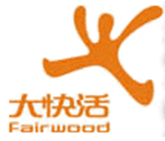
- The simple graphic was made to resemble the Chinese character for 'big' and demonstrate Fairwood's spirit that one could live happily in simple ways. Fairwood furnished restaurants in orange, a colour which also appeals to the appetite. The company changed all its signs on its stores overnight.
- Fairwood's original slogans were '挑戰無限分' (literally, "challenging infinite scores"; note the bilingual pun of "分"-coinciding 'score' with 'fun' in Cantonese pronunciation) in 1990s and '係時候大快活' (literally, "it's Time Fairwood-whose Chinese translation semantically renders as 'enjoying a great time') in 2000, and subsequently changed to '食得夠尖大快活' (literally, "eat posh Fairwood"-meaning 'to eat posh at Fairwood') in 2007 to attract a more youthful crowd with the adoption of marketing campaign featuring celebrities which promoted new choices of food.
- Menu reformulations accompanied the rebranding campaign consisting of revamping signature dishes which were released under the "Ah Wood" brand. These dishes included such favorites as curry beef brisket and baked pork chop over rice. Fairwood also banned smoking in all of its restaurants, a first for any fast food chain in Hong Kong at the time. The company's core "discerning taste" products - curry and tomato dishes, were also updated with new spices and fresh ingredients to meet customers' desires for diversity and healthy ingredients in fast food products. Notably, its light Vongole clam pasta used first-pressed extra virgin olive oil, complete with a dragon fruit salad and low-sugar green tea.
-
Media relations activities revolving around the rebranding campaign consisted of:
- An award-winning local movie-star celebrity, Chapman To (To Man Chak), was hired to front a television and print campaign that drove the new "食得夠尖" slogan in November, 2003.
- The advertising campaign, developed by Interface Communications, sought to create a "discerning eating experience" at Fairwood outlets, including running TV commercials on terrestrial channels and Cable TV as well as print advertisements in local newspapers such as Oriental Daily and Apple Daily. In addition, the restaurant chain distributed point-of-sale promotional materials and in-store displays publicising its new menu at its 74 outlets.
- A ribbon-cutting ceremony for a new flagship outlet was held in Causeway Bay on 18th November, 2003. The new restaurant aimed to redefine and present the company's modern dining concept to customers.
- Fairwood was the first fast food chain to ban smoking in Hong Kong in 2003, aiming to bring about a clean new look to the restaurant chain as part of the rebranding campaign. (Hong Kong's public smoking ban was only enforced in January 2007).
-
Fairwood invested in several strategies to ensure staff loyalty:
- Training was provided for staff to sharpen their supervisory, management and crisis management skills.
- A performance-based reward system was introduced.The Quality Services Cleanliness Index (GSCI), rewarded the top five performing stores each month with cash incentives. The worst five performing stores were penalized with internal disciplinary measures.
- Staff were allowed to become shareholders.
Evaluating effectiveness
- Comments from September 2006 to September 2007 were collected from an on-line public forum (i.e. non-sponsored by Fairwood, which does not run any online forum on its homepage). Respondents were aged between 16 and 40.
- A small scale interview survey was conducted in November 2007 in the Fairwood restaurants in Tsim Sha Tsui and Mong Kok, where many youngsters hung out. There were a total of 60 respondents who were target customers of Fairwood.
Results and Evaluations
- Qualitative findings from on-line forums showed that the target customers described the food and service of Fairwood as satisfactory. The comments were generally positive.
- Questionnaire findings indicated that the respondents found logo, color, slogan and furnishing to be all consistent with the brand image of Fairwood. Overall, 86.7% felt that the re-branding campaign succeeded in attracting customers. In particular, 76.7% of the respondents agreed that the new logo 'Ah Wood' gave them a youthful, happy and energetic feeling while 70% of respondents thought that the orange-themed environment make them feel happy, cozy and relaxed.
- On March 2007, Fairwood announced its plans to increase the number of restaurants to 100 in Hong Kong and to 30 in Mainland China by 2010. Fairwood was awarded the HKMA/TVB 2004 Super Brand Award and the distinguished design for China Merit Prize in 2006 for its 'Ah Wood' ad campaign.
- According to the financial report of Fairwood Holdings Ltd in 2006/07, net profit reached HK$84.7 million, a 46% increase. The turnover increased from 0.9 billion in 2006 to 1.2 billion in 2007. The per capita customer spending amount stood at $25.5 with an increase of 1.8% compared with the year before, while the number of target customers rose by 11.1%. The campaign successfully rejuvenated Fairwood and led to an increase in its turnover.
Reference
Argenti, Paul A.(2007). Corporate Communication. 4th ed., Boston: McGraw-Hill
Website of online public forum: http://www.openrice.com/restaurant/sr2.htm?shopid=5237
Written by Patrick Ng
Case Study - South Africa Corporate Communication Benchmark Study
Background
The period since 1994 has been marked by a number of political, social and economic changes in South Africa, which have deeply influenced the country. South Africa's democratic transformation has created a myriad new opportunities - and challenges - for organizations operating in it. Denton and Vloeberghs (2003) argue that all stakeholders would benefit if they adapted to the competitive international environment and adopted world-class business principles. Given this, corporate communication professionals have a significant role to play in the adaption process - for organizations and their stakeholders.
This benchmarking study of South African corporate communication complements a series of similar studies that were conducted in the USA (1999, 2001, 2002 2003, 2005 and 2006) and China (2006, 2007).
In South Africa an awareness of the importance of corporate communication and public relations has been evident for more than fifty years. It is estimated that there are at least three hundred public relations (PR) or PR-related consultancies currently operating in the country. Public relations-related studies (such as communications studies and journalism) have been on offer in universities since the late 1960s (Niemann-Struweg & Meintjes, 2008). The Public Relations Institute of Southern Africa, a non-profit organization, has been accrediting PR and PR-related qualifications for the past few decades.
Objectives
The study identified the corporate communication structures, practices, and trends of certain South African companies with the intention of answering the following questions:
- What is the role of corporate communication in the company?
- What functions do these companies include as part of their corporate communication tasks?
- To what extent does the company rely on outside agencies to implement its corporate communication functions?
- How does the company position itself in the changing socio-political and economic landscape?
As a benchmark investigation this study forms the foundation for further examination of corporate communication practices in South Africa.
Research Strategy and tactics
The methodology adopted combined quantitative and qualitative research processes. The qualitative aspects of the study were important because they allowed for the expression of a deep understanding of how companies think of, and carry out, their corporate communication.
Sampling
The sampling design used is convenience or purposive sampling. The best-performing 500 South African companies were identified, based on the data provided by Fletcher's study (2007) of this. That study used criteria such as size, growth, profitability, and economic impact. For the purposes of the present study a total of 26 companies were selected from the following three segments identified by Fletcher. These three segments were in turn subdivided into 16 sectors with 30 sub-sectors. From these sub-sectors 26 companies were identified through a convenience sampling process. The research lasted from November 2007 to May 2008. The questionnaire consisted of 30 questions - the majority being quantitative in nature. The interviews were conducted on the premises of the selected companies. The interviewers were in most cases accompanied by a moderator, and they used dictaphones to ensure reliability. Interviews lasted between one and two hours.
Data analysis
The quantitative data were analyzed with the assistance of the University of Johannesburg's Statistical Analysis Unit (Statkon). The quantitative analysis was used mainly to gauge percentages and frequencies of certain variables. A number of cross-tabulations were done. The qualitative analysis was based on the qualitative data model used by Huberman and Miles (1994, in De Vos, 1998). This model proposes the following four processes be applied to the data: reduction, display, conclusion-drawing, and verification. The analysis was based on identified themes - and highlighted the similarities and differences, as well as exceptions, that arose from the data analysis.
Reliability of the data was ensured through methodological and moderator triangulation.
Results
The results of the study can be summarized as follows:
In 86% of companies considered, between 11 and 40 or more corporate communication professionals are employed. In 56% of these cases the professional corporate communication practitioners are supported by up to five support staff, whilst in 22% of all companies the support staff numbered between 11 and 20 employees.
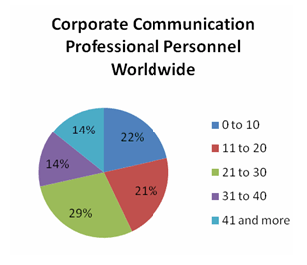 |
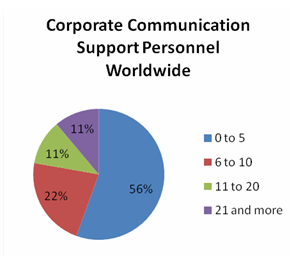 |
The largest number of local professional corporate communication personnel was between 21 and 30 employees, which was the case for 49% of all companies considered. In 34% of cases the total numbers of professional employees were in the category 0 and 10. In 42% of all participating companies the total number of support staff was more than 21. One third of companies indicated support staff numbers in the category 0 and 5.
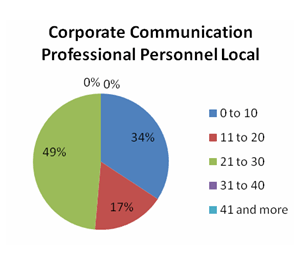 |
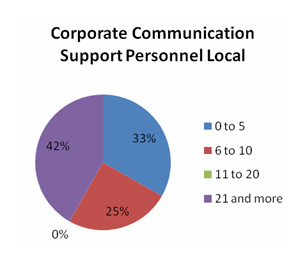 |
Definition of Corporate Communication
Three themes have been identified as key aspects of how the participants viewed Corporate Communication, namely, the Nature of Communication, Marketing and Branding as well as the Management of Information. In order to dissect these three themes further emphasis was placed on three integrated qualities. These were similar, different and exception qualities being part of a vertical and horizontal analysis of the themes and individual responses.
The nature of corporate communication
The single most important similarity between respondents' views regarding the nature of corporate communication was the emphasis on communication with internal and external stakeholders. This was followed by communication about the organization by 'Setting the tone and manner about the company through communication'.
- One difference in opinion was the idea that corporate communication required one to be proactive.
Marketing and branding
- When it came to marketing and branding the emphasis was on internal and external branding as key aspects of corporate communication. This finding relates closely with the previous finding concerning communication with internal and external stakeholders.
- A very strong opinion was expressed - that 'Branding was at the centre of it all'. This was followed in importance by a remark that 'It was all about understanding and knowledge of the organization through branding and marketing which was quite different'.
Information management
- This theme attracted the least emphasis. The single similarity between respondents in this category was that corporate communication was about the 'management of perceptions'.
- The opinion expressed that information management benefits 'shopping' was a rather different take on the information management aspect of corporate communication.
Functions performed by Corporate Communication professionals
The functions performed by corporate communication professionals are illustrated below.

The most prominent functions identified (more than 90% of respondents) were strategic integrated communication; other functions; identity, image and reputation; as well as crisis communication. The lowest scores (less than 70% of respondents) included investor relations; government relations; database management; and cultural diversity. A seemingly contradictory situation presents itself, as is evident in Figure 4, where integrated strategic communication has been identified by participants as being one of the most prominent functions they perform, yet as indicated, a whole number of functions seemed to be regarded as of lesser strategic importance from a corporate communication perspective.
Role preference
Whether participants saw the functions of corporate communication as strategic, managerial, or technical is illustrated below.
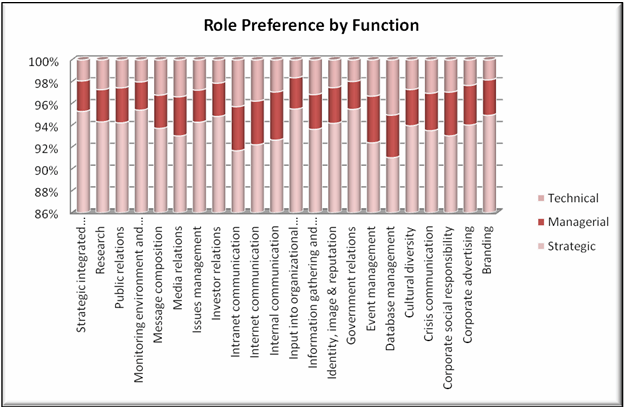
An interesting observation is that in all of the 22 identified roles between 91% and 95% of participants viewed these roles as being predominantly strategic in nature. In contrast, managerial and technical roles scored 5% and 9%, respectively.
Roles performed by Corporate Communication professionals
The roles performed by corporate communication professionals are indicated below.
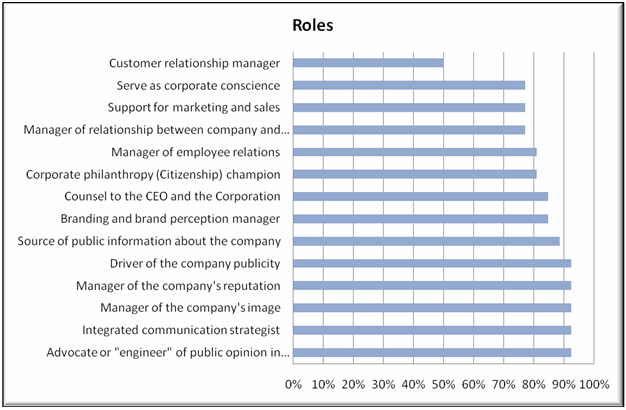
Five roles, more than 90% of the total number identified by respondents, were seen as being the most important of those performed by corporate communication professionals: driver of company publicity, manager of the company's reputation and image, integrated communication strategist, and advocating or engineering public opinion. Other roles that were important in more than 80% of responses included, amongst others, giving counsel to the CEO, and branding and management of the public perception of the company's brand. Customer relationship management came out as the least important role with only 50% of respondents seeing this as important.
Perceptions about the nature of the role of corporate communication
The findings concerning how participants saw their function - as strategic, managerial or technical - are presented below
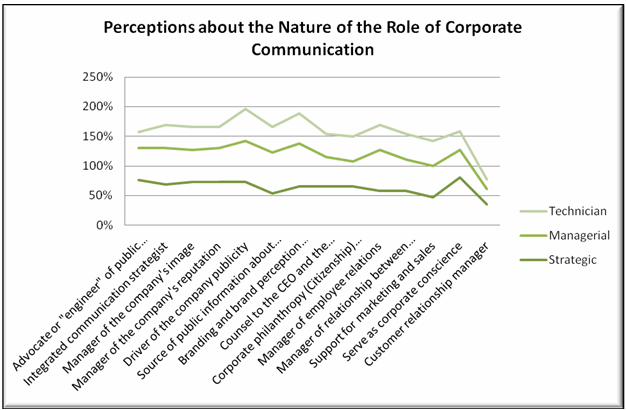
In 14 of the possible roles mentioned, participants perceived their function as being somewhere between managerial and strategic. The importance of corporate communication practitioners in technical roles was seen only when it came to driving the company's publicity; in branding and brand perception management; in corporate philanthropy; in management of employee relations; and in support for marketing and sales.
The managerial function was most important when it came to being the source of public information about the company, in branding and brand perception management, and in the management of employee relations.
Customer relationship management scored the lowest when it came to preferred roles.
Budget
The extent to which corporate communication functions are covered by the budget allocated to them is illustrated below.
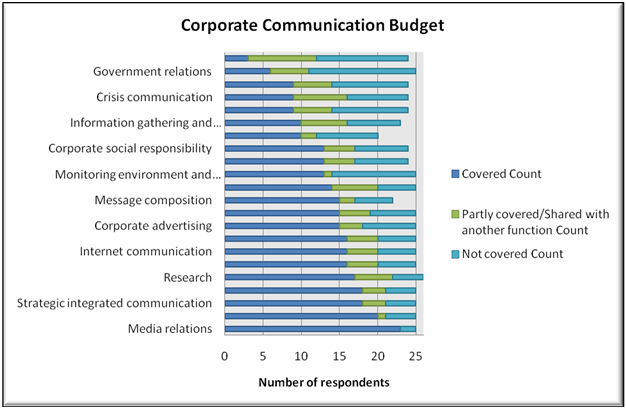
The following were seen as the most important corporate communication functions that had to be fully covered by the corporate communication budget: media relations, strategic integrated communication, research and internet communication. Considered least important to be covered were crisis communication and government relations.
Changes to the corporate communication budget
The extent to which the corporate communication budget had changed from previous years - as well as whether the budget would be among the first or last to be cut - are illustrated below.
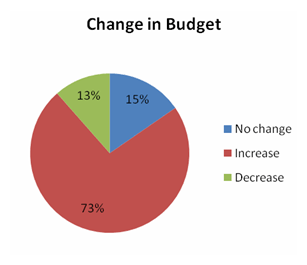 |
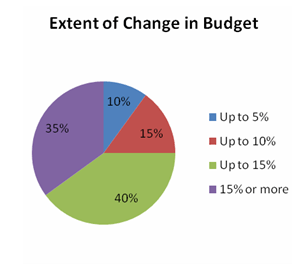 |
|
|
The most prominent observation from Figure 9 (a) is that there was on average a 73% increase in the annual budget for corporate communication. Only in 13% of all cases did the budget decrease. |
The corporate communication budget was increased by up to 15% (for 40% of respondents). Respondents who had increases in their corporate communication budget of 15% or more constituted 35% of the sample. This is in line with the economic growth in the South African economy over the last few years. |
|
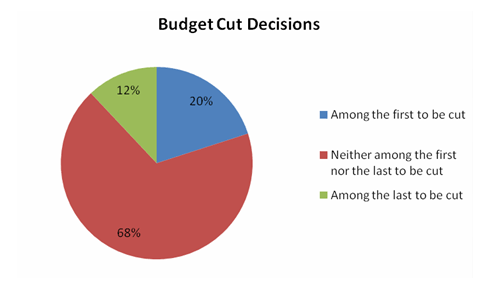
More than two-thirds of all respondents were of the opinion that the corporate communication budget was neither among the first - nor among the last - to be cut, whilst 20% of respondents indicated that their budgets would be the first to be cut.
Use of agencies
The extent to which participants used agencies for corporate communication functions are indicated below.
The most important observation about the use of agencies is that the participants perform their functions in-house - but with some outsourcing. The corporate communication functions which were outsourced the most were input into organizational strategic decision-making, corporate advertising, and research.

Titles and reporting lines
The titles designated to corporate communication practitioners covered a number of permutations of the following roles: communication, corporate communication, marketing, and strategic management. In only seven instances did 'corporate communication' appear in a title along with the terms 'communication' and 'marketing manager'. Titles tended to be very elaborate, with such titles such as 'Group Transformation Manager', 'Manager: Corporate Affairs' and 'Group Director: Sales and Marketing'.
In 16 cases interviews were conducted with the top person responsible for corporate communication. This is important: it was necessary to understand how the decision-makers managed their responsibilities, as well as to understand how they dealt with corporate communication conceptually and practically. The rest of the respondents were intermediaries who reported to the top person responsible of corporate communication.
Conclusions
Participants generally realized the importance of corporate communication as a field that contributes to the functioning of an organization. Participants' views of the role of corporate communication within an organization were generally superficial. They further saw the role of corporate communication within the organization as being largely related to publicity. A further implication of the understanding of the role of Corporate Communication is that it has an effect on the understanding of participants' comprehension of strategic integrated communication, which was also rather narrow. There is a realization among participants that within the organizational context the growth towards integrated management cannot be ignored, as well as working towards a strategic contribution in terms of the role of Corporate Communication. Some inconsistencies became apparent between the emphasis on strategic integrated communication and role and function identification of corporate communication within the organization, which could be regarded as consequence of the superficial understanding of participants of strategic integrated communication. Awareness campaigns received a lot of attention and support from participants - but they could not clearly articulate how such campaigns aligned with the strategic context of corporate communication and that of the organization as a whole. The majority of participants supported professionalization of corporate communication. This indicates the need for recognition and regulation of the industry. Participants were overwhelmingly skeptical about their organizations' commitment to transparency in both practice and philosophy. Furthermore, there was a definite ambivalence among participants between selective commitments to transparency rather than a window dressing approach to transparency. A significant number of participants were not informed enough to comment on the King report in speaking about the relationship of corporate communication and governance. This affects relationships with stakeholders. A fair understanding of the socio-political and economic issues at work in South Africa existed - but participants could not say how these factors (including community development) related to strategic corporate communication.
Evaluation
The distinct lack of understanding among participants regarding the dynamics of communication as a phenomenon and how it manifests in the organizational context could be regarded as not having the suitably empowered individuals in the positions that they fulfill in their organizations. This is evident in participants' limited understanding of alignment issues of corporate communication in the strategic functioning of its role, as well as its contribution to greater organizational strategic direction. The recommendation is therefore to appoint suitably empowered individuals to these positions. There is a high level of awareness among participants about their role within the organization, but there is a failure of knowledge in how to use this to practical advantage. It is therefore recommended that corporate communication personnel be encouraged to make use of continuous learning in order to improve and update their capacity. Limited insight into issues affecting the organization and its relationship with its stakeholders existed. The organization can therefore not be regarded as a learning organisation and thus not respond to organizational challenges and implement changes so as to constantly build long-term strategic relationships with its stakeholders. Again, it is recommended that there should be continuous organizational and professional training programmes in place to deal with this. It was apparent that there is a disintegration of communication in most organizational instances and a lack of team work to ensure consistency and strategic alignment as well as direction in the corporate communication function, which in turn could have significant implications for the strategic functioning of the organization to build and maintain long-term interactive relationships with their various stakeholders. Corporate communication professionals should therefore obtain a true understanding of issues affecting the organization in order to cross-functionally practice corporate communication in strategic alignment of the organization's strategic intent.
References
Denton, M. & Vloeberghs, D. 2003. 'Leadership challenges for organizations in the New South Africa. Leadership & Organization Development Journal, 24(2):84-95.
De Vos, A.A. 1998. Research at grassroots. Pretoria: Van Schaik
Fletcher. R. 2007. Top 500 South Africa's best companies. Cape Town: To Companies Publishing (Pty) Ltd
Niemann-Struweg, I. & Meintjes, C. 2008. 'The professionalism debate in South African public relations'. Public Relations Review. Fall. (Forthcoming in September 2008)
Researchers: Prof Gideon de Wet, Corne Meintjes, Dr Ilse Niemann-Struweg, Dr Michael Goodman. Monash University (South Africa)
Case Study - Pakistan's Pink Ribbon Campaign.
Background
As a professional management function Public Relations is all too often categorised as managed media relations at best and a press relations activity as a default. Most of the measurement and evaluation metrics even professional practitioners use tend to re-enforce this narrow view obscuring a clear view of its role in creating mutual understanding between and engaging stakeholder groups. In public education and particularly public health education the totality of the public relations function can be seen to best effect.
For the past 15 years the Pink Ribbon has become symbol of support for breast cancer awareness world wide or at least throughout the developed world. It has become an emblem of hope for breast cancer sufferers and for those working to fight this curable disease that still claims the lives of too many women in particular. The Pink Ribbon Campaign was brought to Pakistan in 2004 by the Pakistan Women"s Empowerment Group (WEG). It was their response to the chilling fact that Pakistan has the highest rate of breast cancer of any Asian population in the world. It is the commonest cancer observed in females, representing more than one third of female cancers and about one fourth of all malignancies. Approximately 35% of Pakistani women are likely to suffer from breast cancer at some point in their lives. Every fifth woman in Pakistan develops breast cancer after the age of 40. About 77 percent of invasive breast cancers occur in women over 50 years of age but the average age at diagnosis is 64. Advanced breast cancer accounts for 43.7% of cases, accounting for 40,000 deaths per year in Pakistan
Cultural, religious and economic factors limit availability of public health education information on breast cancer and access to advice, early discovery, and treatment. In a first for Pakistan, and any Islamic country, the Women"s Empowerment Group addressed these issues head on launching and establishing a nationwide Breast Cancer Awareness Campaign. The story of that campaign is an object lesson in role of public relations and communication management in overcoming cultural barriers to social development
Planning and Objectives
WEG had been established in 1999 by a group of young professionals from marketing, public relations, the law and medicine. With initial seed funding from USAID they established a reputation for their programmes taking women"s healthcare into rural communities. They took up the challenge to create awareness of breast cancer and in so doing, ran an enormous risk to the Group"s own reputation, possibly even violence against volunteers and staff by venturing into previously forbidden territory.
Working with PIELLEVision the professional public relations firm headed by Omer Aftab, one of those behind the creation of WEG, the Group established Pink Ribbon Pakistan "" the National Breast Cancer Awareness Campaign. Its goal was to become a self funded, nationwide volunteer driven organisation charged with making breast cancer a premier public health concern in Pakistan. Its mission was to become the Centre of Excellence for Breast Cancer Care Information.
Public relations objectives for the Breast Cancer Awareness Campaign were:
- Make breast cancer an acceptable topic in the public domain in Pakistan
- Secure "leadership" support at the highest level
- Promote understanding and the practice of self-diagnosis among women.
- Evoke empathy in the right quarters to support the cause
- Motivate people to contribute funds for campaign execution
- Build a long-term, sustainable platform for future Pink Ribbon campaigns and similar women"s health and well being programmes.
- Stimulate campaign and issue awareness in the Pakistani Diaspora and the wider world of Islam
Strategy and tactics
A clear overriding strategy was established and articulated clearly throughout the organisation and among all those associated with it:
"create widespread awareness about breast cancer and all the key aspects for Pakistan.
Its high incidence, its seriousness leading to fatality, its impact on the life of the sufferer and the whole family, Pakistan"s comparative regional and international position and leadership of breast cancer death rates, and importantly, the good news, that if detected early, breast cancer may be cured".
This was no easy task in country with physical barriers, a very large population, many out of reach of modern media and against a background of cultural and social barriers on women"s issues and health in particular. The Pink Ribbon Campaign used multi-pronged strategies to address the needs of different stakeholders. Tactically, events and communication activities were planned to reflect the core relationships of the campaign. The diagram below shows the stakeholder areas that were and are the focus for discrete but integrated programmes during the campaign:
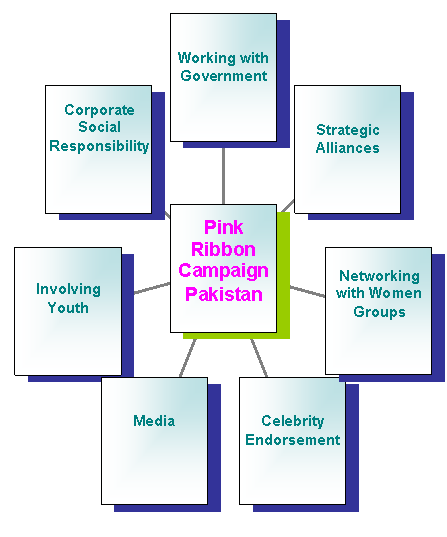
Media relations and press publicity, the traditional anchor for any public relations led campaign posed the greatest challenge. According to Pakistan"s Press Freedom Report 2001-2002... "under the present code of ethics, the difference between obscenity and education is a blur, for example a program on breast cancer is not an educational one but a vulgar programme."?
Getting media, broadcast and print, to accept the Press Freedom Report"s criticism and recommendations for change was to become a secondary challenge. Establishing recognition of the high prevalence of breast cancer in Pakistan and the importance of creating awareness of the issue and the need for mass communication among editors and journalists alike was the campaign"s greatest trial. The Pink Ribbon Campaign"s strategic approach made media realize the gravity of the issue and breast cancer became an integral part of the health programmes they broadcast.
National media coverage and interviews with leaders of the campaign gave a boost to the campaign by bringing to the limelight different events organized at the National and Provincial levels. Similarly, various newspapers and magazines printed special articles on the situation of breast cancer in Pakistan and the services of Pink Ribbon Pakistan. Along with these special transmissions and publications, the media also gave coverage to various Pink Ribbon activities throughout the country.
In 2006 Press Information Department (PID) aired Public Service ads for the first time ever on Breast Cancer, on all State run TV channels. These ads were aired in support of the campaign and the wife of the Prime Minister of Pakistan delivered the message.
International media from the BBC to Voice of America, Yahoo News, Daily Mail, The Times, Khaleej Times, Oman Times, and Hindustan Times also gave momentous exposure to the campaign by giving significant coverage to different events, such as the visit of Jagjit Singh as cultural ambassador for the Indian Government through his peace concert for the campaign, and support from former Miss World Ashwariya Rai.
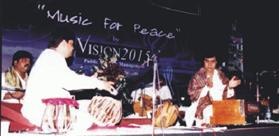
For the BBC Fiona Bruce made a documentary on the visit of Cherie Blair to Pakistan as Patron of Breast Cancer Awareness UK. This 30 minute documentary showed the warm welcome and celebrations organized in honour of the wife of the UK Prime Minister. It showed the plight of a young girl, named Minahil, residing in one of the villages of Punjab and the impact on the family after the death of her mother from breast cancer. It was aired on all channels of BBC throughout the world for over a month.
Print, electronic and broadcast media were not the only communication tools used. WEG Pink Ribbon Publications, viral marketing and merchandising - Pink Ribbon pins, badges, wrist bands, nursery rhyme books and CDs - all played their part. Advertising and publicity were most effective for creating awareness, though the role and effectiveness of different advertising media varied as the campaign moved from one state to another.
Electronic, outdoor media and newspaper articles were most effective in sustaining awareness and establishing comprehension about the issue among the target audience. Newspaper advertisement, brochures and mounted posters were developed to match religious strictures. Posters and leaflets were produced that went beyond cultural norms for display in the waiting rooms of different clinics. They all gave detailed information increasing knowledge about the issues and were most appropriate for disseminating detailed information and creating better understanding and comprehension. Seminars and conferences were used to effectively complement these efforts.
Celebrity endorsement was used with those who had actually benefited from having the disease diagnosed and treated in its initial stages. They were portrayed as everyday heroes to re-enforce the message "that life after cancer was not only possible but is worth living".
Results, reviewing progress
In the four years since WEG committed itself to establishing a national Breast Cancer Awareness campaign it has achieved its goal of a self funded, nationwide volunteer driven organisation. Breast cancer is now a premier public health concern in Pakistan and mission for Pink Ribbon Pakistan to be the Centre of Excellence for Breast Cancer Care Information is a work in progress .
Since October 2004 WEG has:
- Distributed explanatory brochures in easy to understand language to millions of women across the country through various means - utility bills, bank statements, handouts in girls" colleges
- managed a communication campaign through the media including press releases, articles and interviews in the print media and investigative news stories and interviews in the electronic media.
- established a bi-lingual interactive website that enables women to seek and exchange information, ideas and views with each other.
- Prompted and promoted live discussion programs on FM radio and national television.
- Established Volunteer Support Groups nation wide.
- Staged seminars and workshops in various cities and focused presentations to targeted
- audiences like college girls or members of women"s organisations.
- Advanced the campaign objectives through quantifiable incremental progress with
- Every one of its stakeholder groups
A subject which was taboo and very sensitive for an Islamic country like Pakistan is now part of the national agenda for women.
Continuing active public support from the first Lady and the Cherie Blair has encouraged the commitment of national and international business in Pakistan. Women, including those in the rural communities have been involved in creating awareness, providing public education materials, and promoting women"s action to reduce the incidence of breast cancer.
Empathy with the campaign has been established and generated both personal and financial support vital for success and sustainability.
International Aid Agencies "" GTZ (Germany), USAID, UNDP and UNESCO have funded WEG campaigns run with PIELLEVision communication expertise on women"s health and issues.
In 2008, through the involvement of Cherie Blair, the Pakistan Pink Ribbon Campaign Group will join with Breast Cancer Care UK to reach out to the British Pakistani, and British South Asian communities.

"Women are beautiful and survivors of breast cancer are even more beautiful because of the journey they went through."? Mrs. Cherie Blair--- on her visit to Pakistan 2005.
Peter L. Walker FCIPR
was President of the Chartered Institute of Public Relations in 1998 its Golden Jubilee year.
He is Chairman of the PIELLE Consulting Group and,
Chairman "" PIELLE Vision 2015 (Lahore)
www.pielleconsulting.com
Journal of Pakistan Medical Association Vol 53 No.8